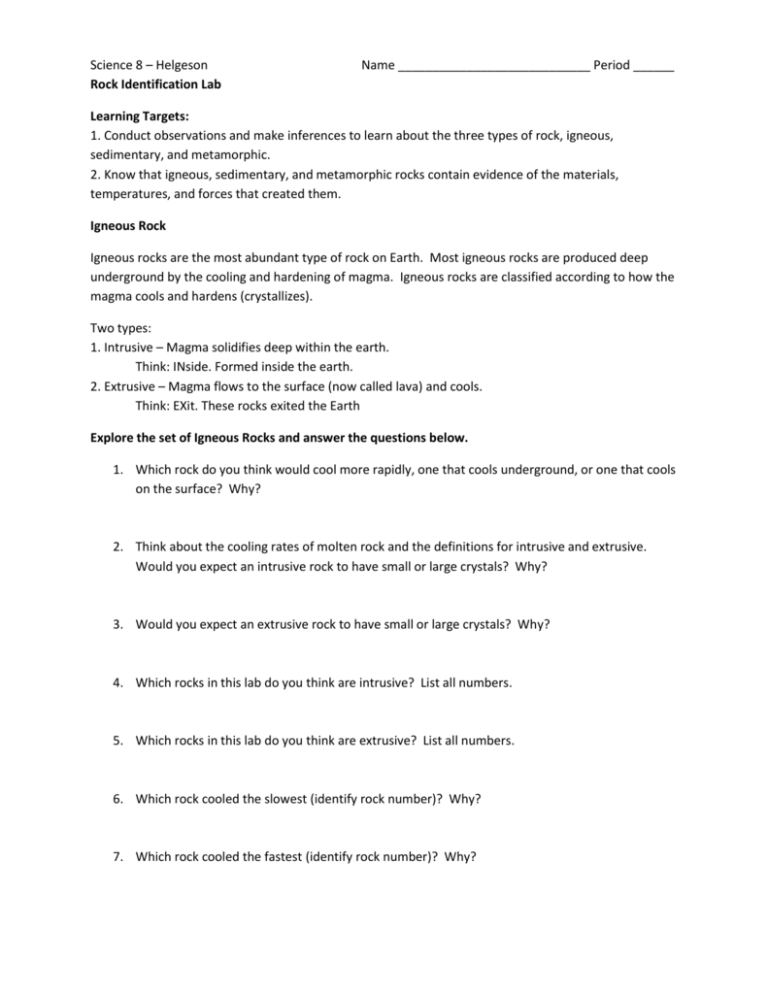Rock ID Lab
advertisement

Science 8 – Helgeson Rock Identification Lab Name ____________________________ Period ______ Learning Targets: 1. Conduct observations and make inferences to learn about the three types of rock, igneous, sedimentary, and metamorphic. 2. Know that igneous, sedimentary, and metamorphic rocks contain evidence of the materials, temperatures, and forces that created them. Igneous Rock Igneous rocks are the most abundant type of rock on Earth. Most igneous rocks are produced deep underground by the cooling and hardening of magma. Igneous rocks are classified according to how the magma cools and hardens (crystallizes). Two types: 1. Intrusive – Magma solidifies deep within the earth. Think: INside. Formed inside the earth. 2. Extrusive – Magma flows to the surface (now called lava) and cools. Think: EXit. These rocks exited the Earth Explore the set of Igneous Rocks and answer the questions below. 1. Which rock do you think would cool more rapidly, one that cools underground, or one that cools on the surface? Why? 2. Think about the cooling rates of molten rock and the definitions for intrusive and extrusive. Would you expect an intrusive rock to have small or large crystals? Why? 3. Would you expect an extrusive rock to have small or large crystals? Why? 4. Which rocks in this lab do you think are intrusive? List all numbers. 5. Which rocks in this lab do you think are extrusive? List all numbers. 6. Which rock cooled the slowest (identify rock number)? Why? 7. Which rock cooled the fastest (identify rock number)? Why? Sedimentary Rock Sedimentary rocks form from the cementing together of Earth’s materials called sediment (clay, sand, pebbles, gravel, plants or animal remains). 75% of the rocks at Earth’s surface are sedimentary rocks. Sedimentary rocks are categorized based on sediment type. Three types: 1. Fragmental – formed from the broken pieces of other rocks (clastics). Grain size is important in determining the textures (coarse, medium, or fine). 2. Organic – formed directly or indirectly from once-living materials. 3. Chemical – formed when a sea or lake dries up leaving behind large amounts of minerals Explore the set of Sedimentary Rocks and answer the questions below. 1. Which rocks seem to be created from fragments? List all numbers. 2. Rank the rocks identified in Question #1 in particle size, from largest to smallest. 3. Which rocks seem to be organic in nature? List all numbers. 4. Which rocks seem to be made by chemical means? (either precipitation or evaporation) List all numbers. 5. What processes help to create sedimentary rocks? Hint: Think about the processes of the rock cycle. 6. Explain how a river or stream carries the different sizes of sediments down a river. What happens as the river slows down and the force decreases? What effect does the river have on the shape of rock fragments as it is moved down the river? Metamorphic Rock Metamorphic rocks are formed when high heat and pressure changes the original or parent rock into a completely new rock. The parent rock can be either sedimentary, igneous, or even another metamorphic rock. Increasing temperature and pressure occurs inside the crust of the Earth, making metamorphic rocks the most difficult to understand and to identify. Foliated metamorphic rocks have a sheet like or layering orientation of their minerals. Nonfoliated metamorphic rocks are composed of mineral grains that don’t form layers. Explore the set of Metamorphic Rocks and answer the questions below. 1. Which rocks in this lab do you think are foliated? List all numbers. 2. Which rocks in this lab do you think are nonfoliated? List all numbers. 3. Which rock samples were the most difficult to identify as metamorphic rock? 4. Suggest why two samples of the same type of metamorphic rock might look different from each other. Hint: Think about how metamorphic rocks are formed. Conclusion What is the difference between igneous, sedimentary, and metamorphic rock?







